Psychology 12 Report: Theories of Adolescent Transition in Singapore
VerifiedAdded on 2022/10/13
|13
|3529
|331
Report
AI Summary
This report provides an in-depth exploration of the transition from late childhood to adolescence, focusing on the developmental changes and relevant psychological theories applicable to 12-year-olds in Singapore. The paper examines physical, cognitive, and psychosocial developments, including puberty, cognitive development according to Piaget, and socio-emotional changes such as identity formation and self-esteem. It also discusses the influence of family, peers, and culture on adolescent development. The report applies theories like Freud's psychosexual theory and Erikson's psychosocial model, offering insights into the challenges faced by adolescents and the role of parents and teachers. Furthermore, the paper incorporates personal experiences to illustrate the concepts discussed, emphasizing the importance of positive influences in navigating this transitional phase. The conclusion highlights the significance of understanding these changes to support healthy adolescent development.

Running head: PSYCHOLOGY
PSYCHOLOGY
Name of the student:
Name of the university:
Author note
PSYCHOLOGY
Name of the student:
Name of the university:
Author note
Paraphrase This Document
Need a fresh take? Get an instant paraphrase of this document with our AI Paraphraser
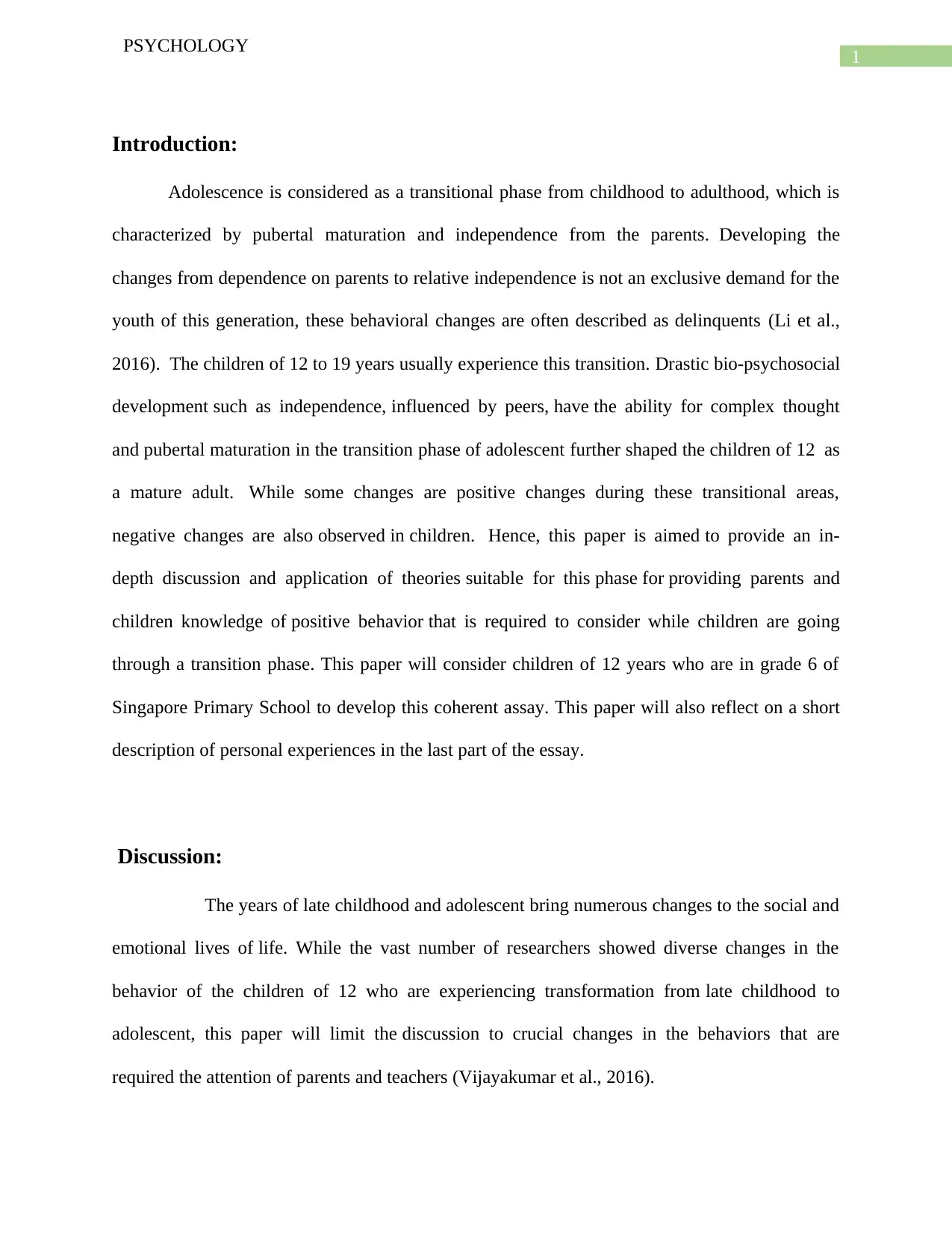
1
PSYCHOLOGY
Introduction:
Adolescence is considered as a transitional phase from childhood to adulthood, which is
characterized by pubertal maturation and independence from the parents. Developing the
changes from dependence on parents to relative independence is not an exclusive demand for the
youth of this generation, these behavioral changes are often described as delinquents (Li et al.,
2016). The children of 12 to 19 years usually experience this transition. Drastic bio-psychosocial
development such as independence, influenced by peers, have the ability for complex thought
and pubertal maturation in the transition phase of adolescent further shaped the children of 12 as
a mature adult. While some changes are positive changes during these transitional areas,
negative changes are also observed in children. Hence, this paper is aimed to provide an in-
depth discussion and application of theories suitable for this phase for providing parents and
children knowledge of positive behavior that is required to consider while children are going
through a transition phase. This paper will consider children of 12 years who are in grade 6 of
Singapore Primary School to develop this coherent assay. This paper will also reflect on a short
description of personal experiences in the last part of the essay.
Discussion:
The years of late childhood and adolescent bring numerous changes to the social and
emotional lives of life. While the vast number of researchers showed diverse changes in the
behavior of the children of 12 who are experiencing transformation from late childhood to
adolescent, this paper will limit the discussion to crucial changes in the behaviors that are
required the attention of parents and teachers (Vijayakumar et al., 2016).
PSYCHOLOGY
Introduction:
Adolescence is considered as a transitional phase from childhood to adulthood, which is
characterized by pubertal maturation and independence from the parents. Developing the
changes from dependence on parents to relative independence is not an exclusive demand for the
youth of this generation, these behavioral changes are often described as delinquents (Li et al.,
2016). The children of 12 to 19 years usually experience this transition. Drastic bio-psychosocial
development such as independence, influenced by peers, have the ability for complex thought
and pubertal maturation in the transition phase of adolescent further shaped the children of 12 as
a mature adult. While some changes are positive changes during these transitional areas,
negative changes are also observed in children. Hence, this paper is aimed to provide an in-
depth discussion and application of theories suitable for this phase for providing parents and
children knowledge of positive behavior that is required to consider while children are going
through a transition phase. This paper will consider children of 12 years who are in grade 6 of
Singapore Primary School to develop this coherent assay. This paper will also reflect on a short
description of personal experiences in the last part of the essay.
Discussion:
The years of late childhood and adolescent bring numerous changes to the social and
emotional lives of life. While the vast number of researchers showed diverse changes in the
behavior of the children of 12 who are experiencing transformation from late childhood to
adolescent, this paper will limit the discussion to crucial changes in the behaviors that are
required the attention of parents and teachers (Vijayakumar et al., 2016).
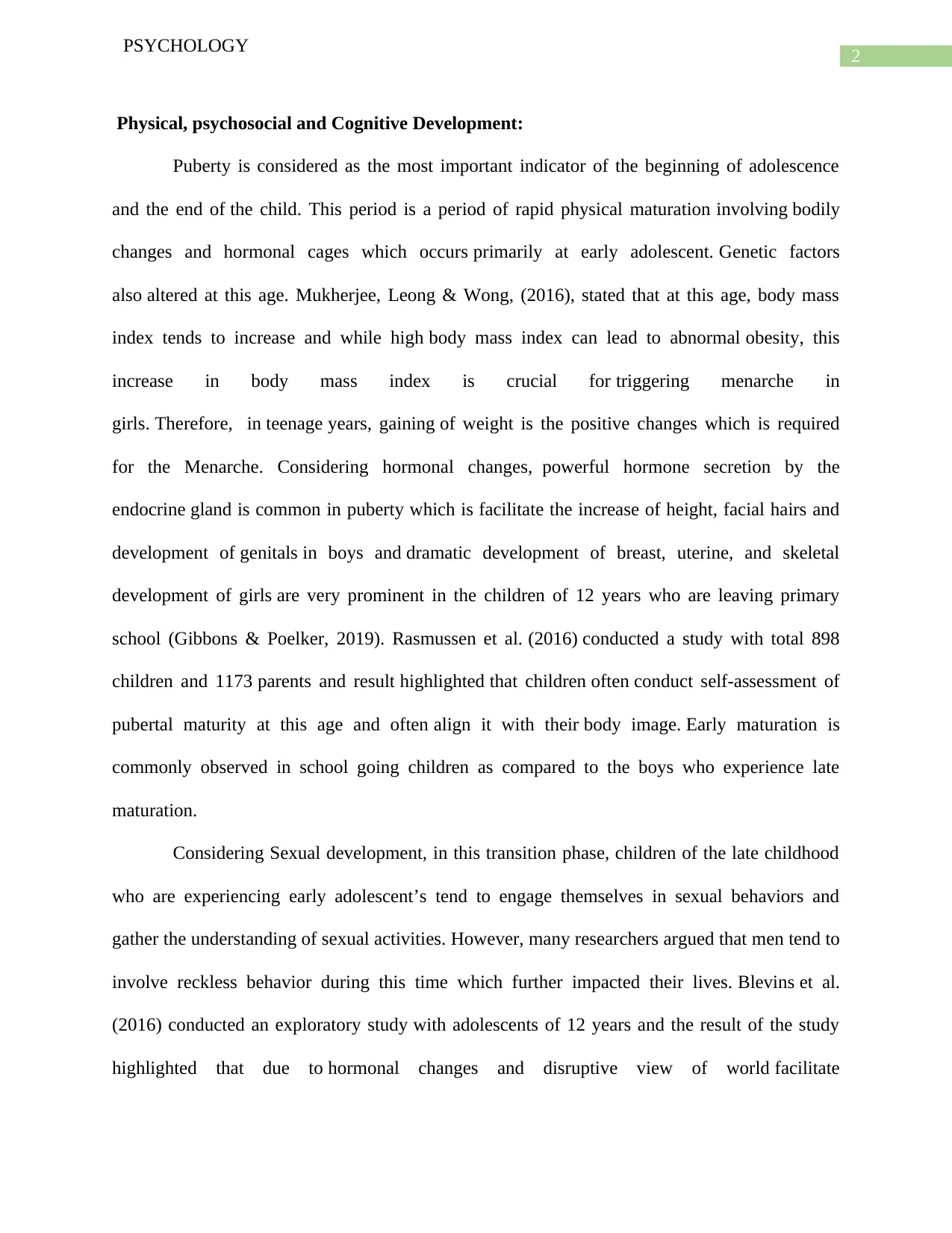
2
PSYCHOLOGY
Physical, psychosocial and Cognitive Development:
Puberty is considered as the most important indicator of the beginning of adolescence
and the end of the child. This period is a period of rapid physical maturation involving bodily
changes and hormonal cages which occurs primarily at early adolescent. Genetic factors
also altered at this age. Mukherjee, Leong & Wong, (2016), stated that at this age, body mass
index tends to increase and while high body mass index can lead to abnormal obesity, this
increase in body mass index is crucial for triggering menarche in
girls. Therefore, in teenage years, gaining of weight is the positive changes which is required
for the Menarche. Considering hormonal changes, powerful hormone secretion by the
endocrine gland is common in puberty which is facilitate the increase of height, facial hairs and
development of genitals in boys and dramatic development of breast, uterine, and skeletal
development of girls are very prominent in the children of 12 years who are leaving primary
school (Gibbons & Poelker, 2019). Rasmussen et al. (2016) conducted a study with total 898
children and 1173 parents and result highlighted that children often conduct self-assessment of
pubertal maturity at this age and often align it with their body image. Early maturation is
commonly observed in school going children as compared to the boys who experience late
maturation.
Considering Sexual development, in this transition phase, children of the late childhood
who are experiencing early adolescent’s tend to engage themselves in sexual behaviors and
gather the understanding of sexual activities. However, many researchers argued that men tend to
involve reckless behavior during this time which further impacted their lives. Blevins et al.
(2016) conducted an exploratory study with adolescents of 12 years and the result of the study
highlighted that due to hormonal changes and disruptive view of world facilitate
PSYCHOLOGY
Physical, psychosocial and Cognitive Development:
Puberty is considered as the most important indicator of the beginning of adolescence
and the end of the child. This period is a period of rapid physical maturation involving bodily
changes and hormonal cages which occurs primarily at early adolescent. Genetic factors
also altered at this age. Mukherjee, Leong & Wong, (2016), stated that at this age, body mass
index tends to increase and while high body mass index can lead to abnormal obesity, this
increase in body mass index is crucial for triggering menarche in
girls. Therefore, in teenage years, gaining of weight is the positive changes which is required
for the Menarche. Considering hormonal changes, powerful hormone secretion by the
endocrine gland is common in puberty which is facilitate the increase of height, facial hairs and
development of genitals in boys and dramatic development of breast, uterine, and skeletal
development of girls are very prominent in the children of 12 years who are leaving primary
school (Gibbons & Poelker, 2019). Rasmussen et al. (2016) conducted a study with total 898
children and 1173 parents and result highlighted that children often conduct self-assessment of
pubertal maturity at this age and often align it with their body image. Early maturation is
commonly observed in school going children as compared to the boys who experience late
maturation.
Considering Sexual development, in this transition phase, children of the late childhood
who are experiencing early adolescent’s tend to engage themselves in sexual behaviors and
gather the understanding of sexual activities. However, many researchers argued that men tend to
involve reckless behavior during this time which further impacted their lives. Blevins et al.
(2016) conducted an exploratory study with adolescents of 12 years and the result of the study
highlighted that due to hormonal changes and disruptive view of world facilitate
⊘ This is a preview!⊘
Do you want full access?
Subscribe today to unlock all pages.

Trusted by 1+ million students worldwide
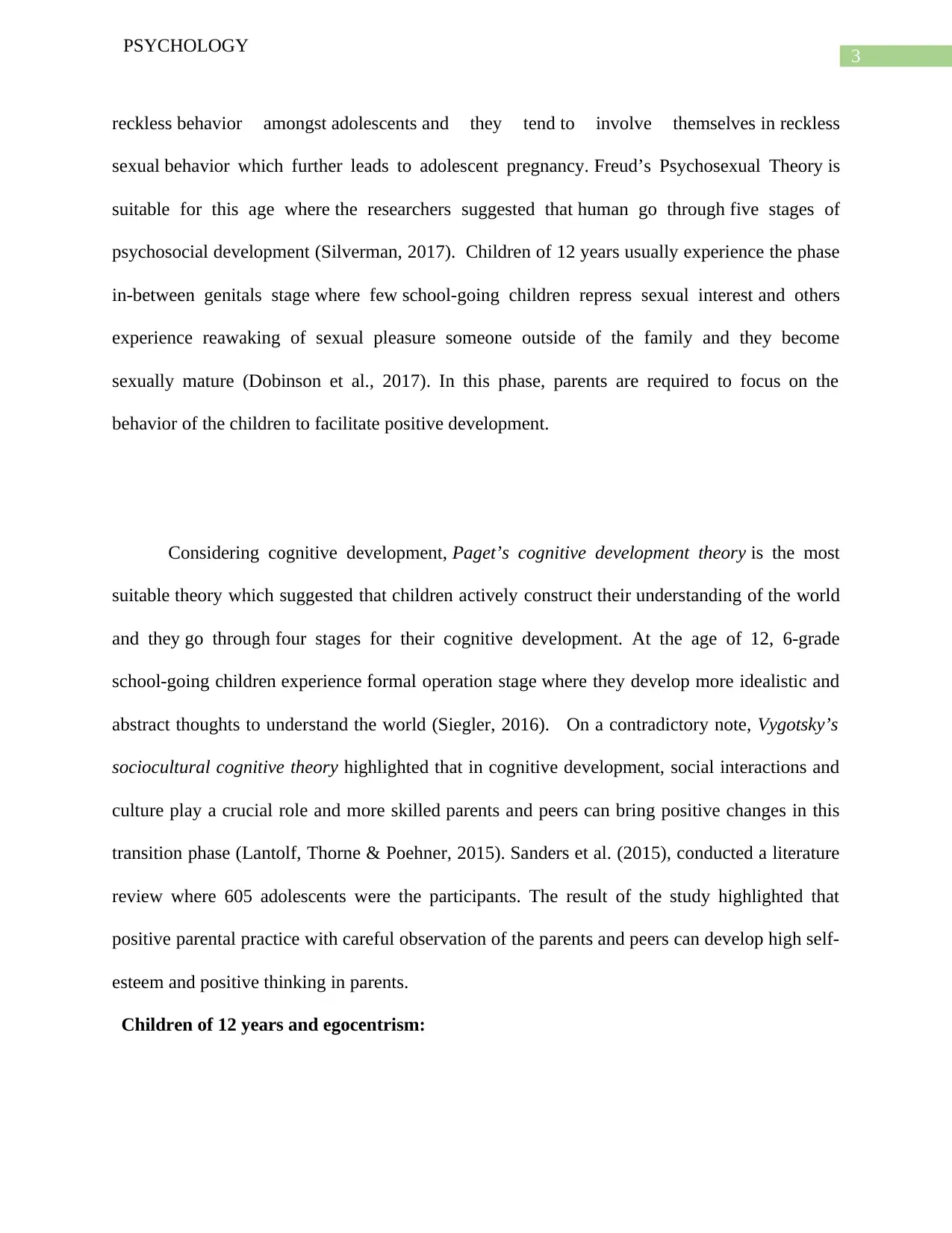
3
PSYCHOLOGY
reckless behavior amongst adolescents and they tend to involve themselves in reckless
sexual behavior which further leads to adolescent pregnancy. Freud’s Psychosexual Theory is
suitable for this age where the researchers suggested that human go through five stages of
psychosocial development (Silverman, 2017). Children of 12 years usually experience the phase
in-between genitals stage where few school-going children repress sexual interest and others
experience reawaking of sexual pleasure someone outside of the family and they become
sexually mature (Dobinson et al., 2017). In this phase, parents are required to focus on the
behavior of the children to facilitate positive development.
Considering cognitive development, Paget’s cognitive development theory is the most
suitable theory which suggested that children actively construct their understanding of the world
and they go through four stages for their cognitive development. At the age of 12, 6-grade
school-going children experience formal operation stage where they develop more idealistic and
abstract thoughts to understand the world (Siegler, 2016). On a contradictory note, Vygotsky’s
sociocultural cognitive theory highlighted that in cognitive development, social interactions and
culture play a crucial role and more skilled parents and peers can bring positive changes in this
transition phase (Lantolf, Thorne & Poehner, 2015). Sanders et al. (2015), conducted a literature
review where 605 adolescents were the participants. The result of the study highlighted that
positive parental practice with careful observation of the parents and peers can develop high self-
esteem and positive thinking in parents.
Children of 12 years and egocentrism:
PSYCHOLOGY
reckless behavior amongst adolescents and they tend to involve themselves in reckless
sexual behavior which further leads to adolescent pregnancy. Freud’s Psychosexual Theory is
suitable for this age where the researchers suggested that human go through five stages of
psychosocial development (Silverman, 2017). Children of 12 years usually experience the phase
in-between genitals stage where few school-going children repress sexual interest and others
experience reawaking of sexual pleasure someone outside of the family and they become
sexually mature (Dobinson et al., 2017). In this phase, parents are required to focus on the
behavior of the children to facilitate positive development.
Considering cognitive development, Paget’s cognitive development theory is the most
suitable theory which suggested that children actively construct their understanding of the world
and they go through four stages for their cognitive development. At the age of 12, 6-grade
school-going children experience formal operation stage where they develop more idealistic and
abstract thoughts to understand the world (Siegler, 2016). On a contradictory note, Vygotsky’s
sociocultural cognitive theory highlighted that in cognitive development, social interactions and
culture play a crucial role and more skilled parents and peers can bring positive changes in this
transition phase (Lantolf, Thorne & Poehner, 2015). Sanders et al. (2015), conducted a literature
review where 605 adolescents were the participants. The result of the study highlighted that
positive parental practice with careful observation of the parents and peers can develop high self-
esteem and positive thinking in parents.
Children of 12 years and egocentrism:
Paraphrase This Document
Need a fresh take? Get an instant paraphrase of this document with our AI Paraphraser
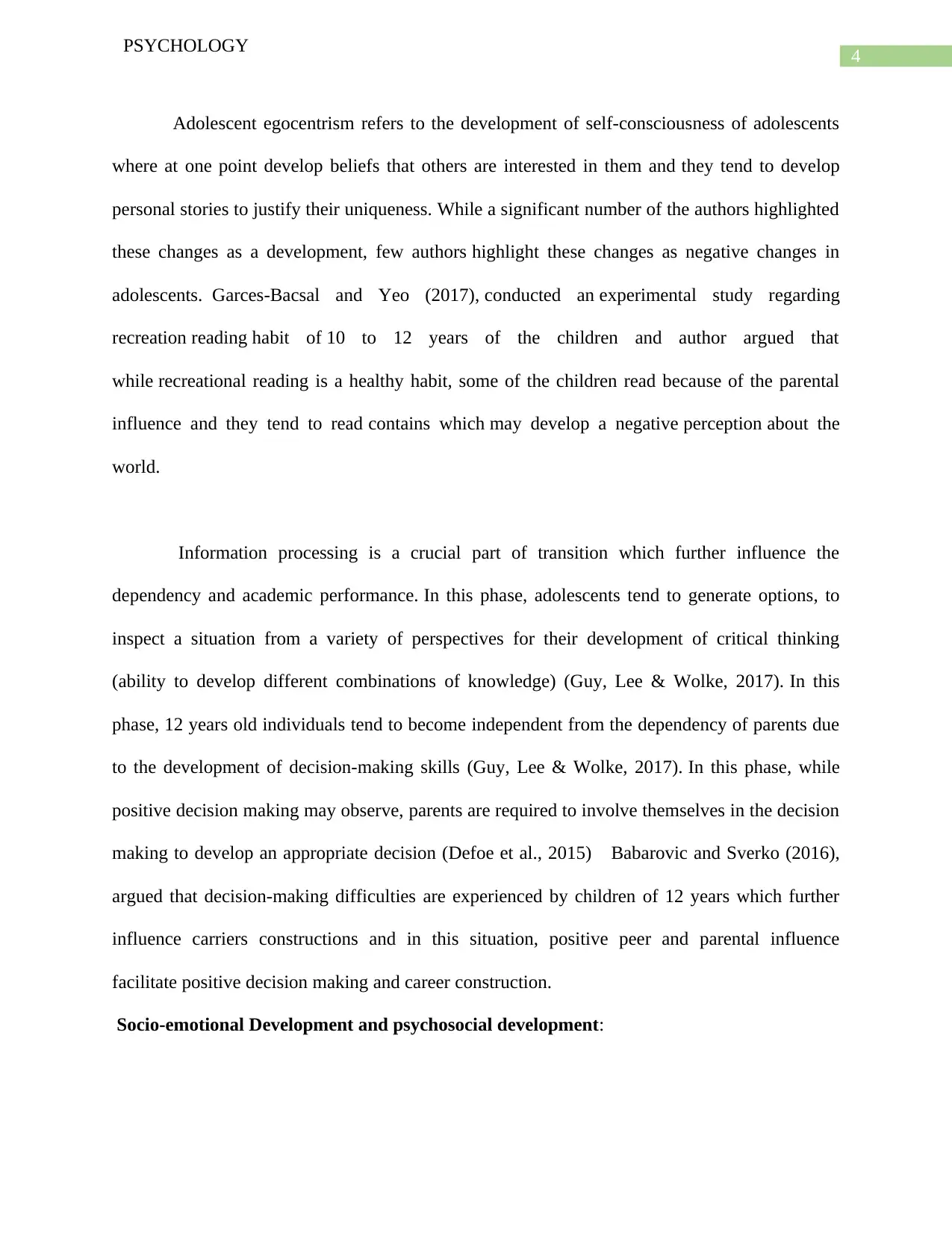
4
PSYCHOLOGY
Adolescent egocentrism refers to the development of self-consciousness of adolescents
where at one point develop beliefs that others are interested in them and they tend to develop
personal stories to justify their uniqueness. While a significant number of the authors highlighted
these changes as a development, few authors highlight these changes as negative changes in
adolescents. Garces-Bacsal and Yeo (2017), conducted an experimental study regarding
recreation reading habit of 10 to 12 years of the children and author argued that
while recreational reading is a healthy habit, some of the children read because of the parental
influence and they tend to read contains which may develop a negative perception about the
world.
Information processing is a crucial part of transition which further influence the
dependency and academic performance. In this phase, adolescents tend to generate options, to
inspect a situation from a variety of perspectives for their development of critical thinking
(ability to develop different combinations of knowledge) (Guy, Lee & Wolke, 2017). In this
phase, 12 years old individuals tend to become independent from the dependency of parents due
to the development of decision-making skills (Guy, Lee & Wolke, 2017). In this phase, while
positive decision making may observe, parents are required to involve themselves in the decision
making to develop an appropriate decision (Defoe et al., 2015) Babarovic and Sverko (2016),
argued that decision-making difficulties are experienced by children of 12 years which further
influence carriers constructions and in this situation, positive peer and parental influence
facilitate positive decision making and career construction.
Socio-emotional Development and psychosocial development:
PSYCHOLOGY
Adolescent egocentrism refers to the development of self-consciousness of adolescents
where at one point develop beliefs that others are interested in them and they tend to develop
personal stories to justify their uniqueness. While a significant number of the authors highlighted
these changes as a development, few authors highlight these changes as negative changes in
adolescents. Garces-Bacsal and Yeo (2017), conducted an experimental study regarding
recreation reading habit of 10 to 12 years of the children and author argued that
while recreational reading is a healthy habit, some of the children read because of the parental
influence and they tend to read contains which may develop a negative perception about the
world.
Information processing is a crucial part of transition which further influence the
dependency and academic performance. In this phase, adolescents tend to generate options, to
inspect a situation from a variety of perspectives for their development of critical thinking
(ability to develop different combinations of knowledge) (Guy, Lee & Wolke, 2017). In this
phase, 12 years old individuals tend to become independent from the dependency of parents due
to the development of decision-making skills (Guy, Lee & Wolke, 2017). In this phase, while
positive decision making may observe, parents are required to involve themselves in the decision
making to develop an appropriate decision (Defoe et al., 2015) Babarovic and Sverko (2016),
argued that decision-making difficulties are experienced by children of 12 years which further
influence carriers constructions and in this situation, positive peer and parental influence
facilitate positive decision making and career construction.
Socio-emotional Development and psychosocial development:
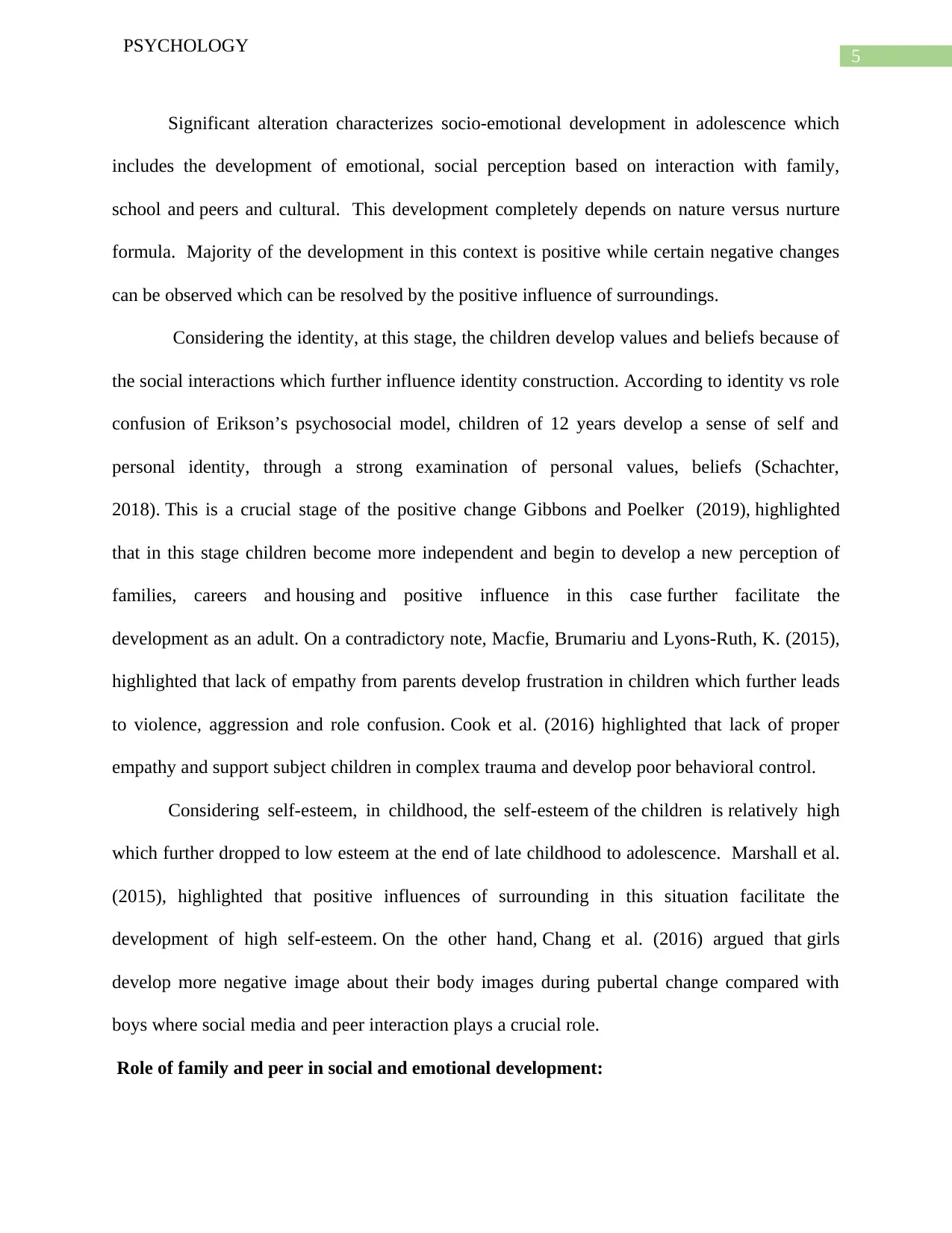
5
PSYCHOLOGY
Significant alteration characterizes socio-emotional development in adolescence which
includes the development of emotional, social perception based on interaction with family,
school and peers and cultural. This development completely depends on nature versus nurture
formula. Majority of the development in this context is positive while certain negative changes
can be observed which can be resolved by the positive influence of surroundings.
Considering the identity, at this stage, the children develop values and beliefs because of
the social interactions which further influence identity construction. According to identity vs role
confusion of Erikson’s psychosocial model, children of 12 years develop a sense of self and
personal identity, through a strong examination of personal values, beliefs (Schachter,
2018). This is a crucial stage of the positive change Gibbons and Poelker (2019), highlighted
that in this stage children become more independent and begin to develop a new perception of
families, careers and housing and positive influence in this case further facilitate the
development as an adult. On a contradictory note, Macfie, Brumariu and Lyons-Ruth, K. (2015),
highlighted that lack of empathy from parents develop frustration in children which further leads
to violence, aggression and role confusion. Cook et al. (2016) highlighted that lack of proper
empathy and support subject children in complex trauma and develop poor behavioral control.
Considering self-esteem, in childhood, the self-esteem of the children is relatively high
which further dropped to low esteem at the end of late childhood to adolescence. Marshall et al.
(2015), highlighted that positive influences of surrounding in this situation facilitate the
development of high self-esteem. On the other hand, Chang et al. (2016) argued that girls
develop more negative image about their body images during pubertal change compared with
boys where social media and peer interaction plays a crucial role.
Role of family and peer in social and emotional development:
PSYCHOLOGY
Significant alteration characterizes socio-emotional development in adolescence which
includes the development of emotional, social perception based on interaction with family,
school and peers and cultural. This development completely depends on nature versus nurture
formula. Majority of the development in this context is positive while certain negative changes
can be observed which can be resolved by the positive influence of surroundings.
Considering the identity, at this stage, the children develop values and beliefs because of
the social interactions which further influence identity construction. According to identity vs role
confusion of Erikson’s psychosocial model, children of 12 years develop a sense of self and
personal identity, through a strong examination of personal values, beliefs (Schachter,
2018). This is a crucial stage of the positive change Gibbons and Poelker (2019), highlighted
that in this stage children become more independent and begin to develop a new perception of
families, careers and housing and positive influence in this case further facilitate the
development as an adult. On a contradictory note, Macfie, Brumariu and Lyons-Ruth, K. (2015),
highlighted that lack of empathy from parents develop frustration in children which further leads
to violence, aggression and role confusion. Cook et al. (2016) highlighted that lack of proper
empathy and support subject children in complex trauma and develop poor behavioral control.
Considering self-esteem, in childhood, the self-esteem of the children is relatively high
which further dropped to low esteem at the end of late childhood to adolescence. Marshall et al.
(2015), highlighted that positive influences of surrounding in this situation facilitate the
development of high self-esteem. On the other hand, Chang et al. (2016) argued that girls
develop more negative image about their body images during pubertal change compared with
boys where social media and peer interaction plays a crucial role.
Role of family and peer in social and emotional development:
⊘ This is a preview!⊘
Do you want full access?
Subscribe today to unlock all pages.

Trusted by 1+ million students worldwide
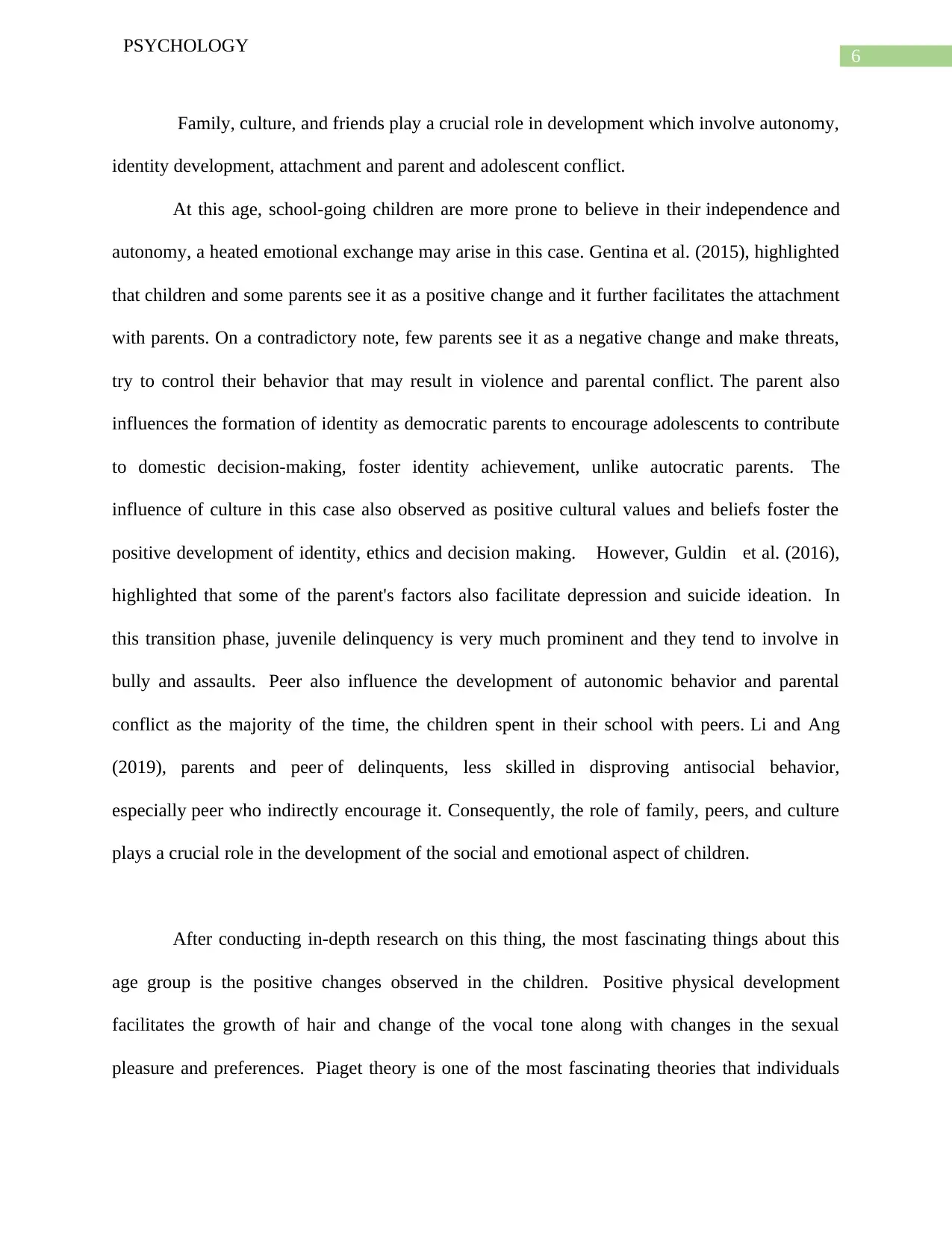
6
PSYCHOLOGY
Family, culture, and friends play a crucial role in development which involve autonomy,
identity development, attachment and parent and adolescent conflict.
At this age, school-going children are more prone to believe in their independence and
autonomy, a heated emotional exchange may arise in this case. Gentina et al. (2015), highlighted
that children and some parents see it as a positive change and it further facilitates the attachment
with parents. On a contradictory note, few parents see it as a negative change and make threats,
try to control their behavior that may result in violence and parental conflict. The parent also
influences the formation of identity as democratic parents to encourage adolescents to contribute
to domestic decision-making, foster identity achievement, unlike autocratic parents. The
influence of culture in this case also observed as positive cultural values and beliefs foster the
positive development of identity, ethics and decision making. However, Guldin et al. (2016),
highlighted that some of the parent's factors also facilitate depression and suicide ideation. In
this transition phase, juvenile delinquency is very much prominent and they tend to involve in
bully and assaults. Peer also influence the development of autonomic behavior and parental
conflict as the majority of the time, the children spent in their school with peers. Li and Ang
(2019), parents and peer of delinquents, less skilled in disproving antisocial behavior,
especially peer who indirectly encourage it. Consequently, the role of family, peers, and culture
plays a crucial role in the development of the social and emotional aspect of children.
After conducting in-depth research on this thing, the most fascinating things about this
age group is the positive changes observed in the children. Positive physical development
facilitates the growth of hair and change of the vocal tone along with changes in the sexual
pleasure and preferences. Piaget theory is one of the most fascinating theories that individuals
PSYCHOLOGY
Family, culture, and friends play a crucial role in development which involve autonomy,
identity development, attachment and parent and adolescent conflict.
At this age, school-going children are more prone to believe in their independence and
autonomy, a heated emotional exchange may arise in this case. Gentina et al. (2015), highlighted
that children and some parents see it as a positive change and it further facilitates the attachment
with parents. On a contradictory note, few parents see it as a negative change and make threats,
try to control their behavior that may result in violence and parental conflict. The parent also
influences the formation of identity as democratic parents to encourage adolescents to contribute
to domestic decision-making, foster identity achievement, unlike autocratic parents. The
influence of culture in this case also observed as positive cultural values and beliefs foster the
positive development of identity, ethics and decision making. However, Guldin et al. (2016),
highlighted that some of the parent's factors also facilitate depression and suicide ideation. In
this transition phase, juvenile delinquency is very much prominent and they tend to involve in
bully and assaults. Peer also influence the development of autonomic behavior and parental
conflict as the majority of the time, the children spent in their school with peers. Li and Ang
(2019), parents and peer of delinquents, less skilled in disproving antisocial behavior,
especially peer who indirectly encourage it. Consequently, the role of family, peers, and culture
plays a crucial role in the development of the social and emotional aspect of children.
After conducting in-depth research on this thing, the most fascinating things about this
age group is the positive changes observed in the children. Positive physical development
facilitates the growth of hair and change of the vocal tone along with changes in the sexual
pleasure and preferences. Piaget theory is one of the most fascinating theories that individuals
Paraphrase This Document
Need a fresh take? Get an instant paraphrase of this document with our AI Paraphraser
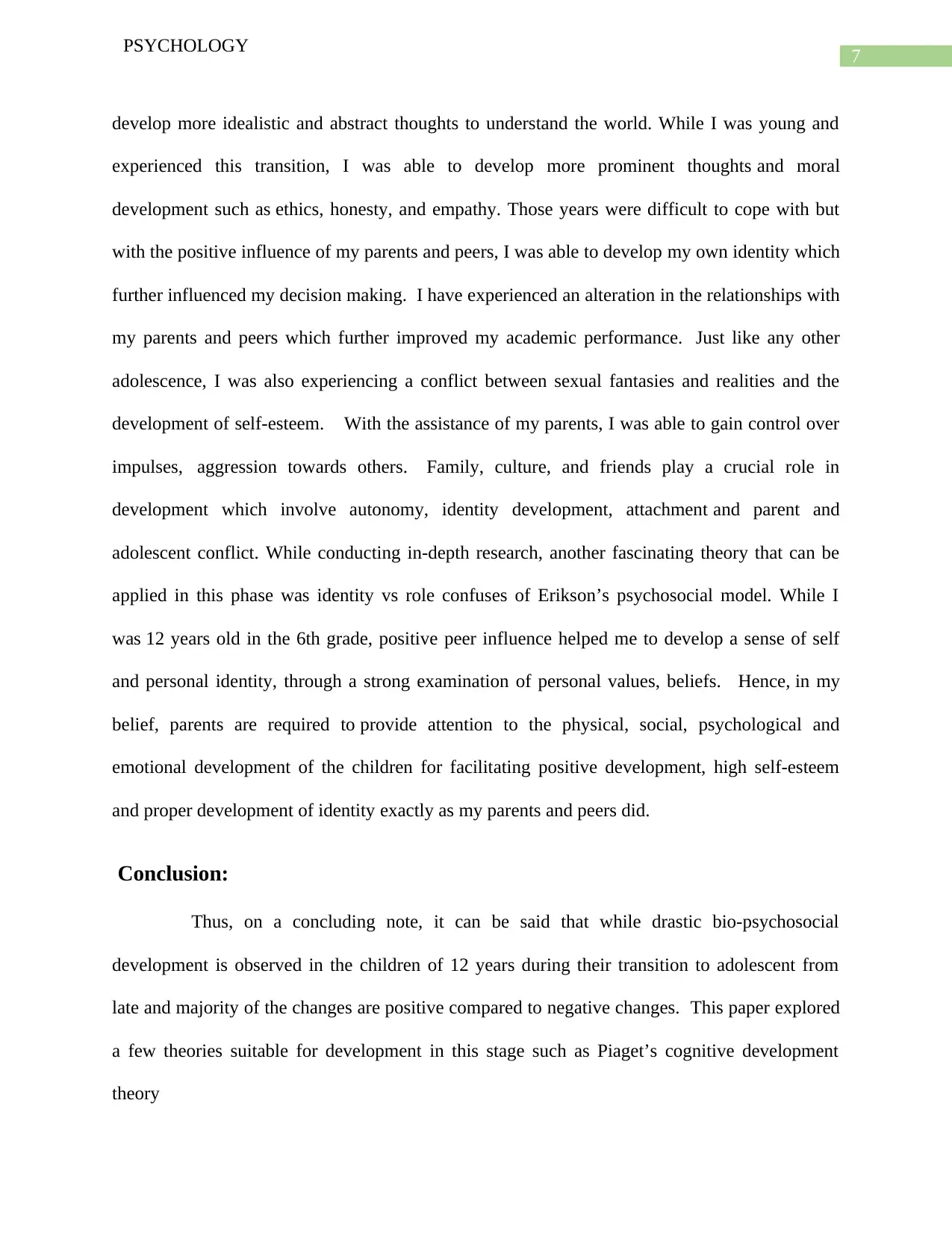
7
PSYCHOLOGY
develop more idealistic and abstract thoughts to understand the world. While I was young and
experienced this transition, I was able to develop more prominent thoughts and moral
development such as ethics, honesty, and empathy. Those years were difficult to cope with but
with the positive influence of my parents and peers, I was able to develop my own identity which
further influenced my decision making. I have experienced an alteration in the relationships with
my parents and peers which further improved my academic performance. Just like any other
adolescence, I was also experiencing a conflict between sexual fantasies and realities and the
development of self-esteem. With the assistance of my parents, I was able to gain control over
impulses, aggression towards others. Family, culture, and friends play a crucial role in
development which involve autonomy, identity development, attachment and parent and
adolescent conflict. While conducting in-depth research, another fascinating theory that can be
applied in this phase was identity vs role confuses of Erikson’s psychosocial model. While I
was 12 years old in the 6th grade, positive peer influence helped me to develop a sense of self
and personal identity, through a strong examination of personal values, beliefs. Hence, in my
belief, parents are required to provide attention to the physical, social, psychological and
emotional development of the children for facilitating positive development, high self-esteem
and proper development of identity exactly as my parents and peers did.
Conclusion:
Thus, on a concluding note, it can be said that while drastic bio-psychosocial
development is observed in the children of 12 years during their transition to adolescent from
late and majority of the changes are positive compared to negative changes. This paper explored
a few theories suitable for development in this stage such as Piaget’s cognitive development
theory
PSYCHOLOGY
develop more idealistic and abstract thoughts to understand the world. While I was young and
experienced this transition, I was able to develop more prominent thoughts and moral
development such as ethics, honesty, and empathy. Those years were difficult to cope with but
with the positive influence of my parents and peers, I was able to develop my own identity which
further influenced my decision making. I have experienced an alteration in the relationships with
my parents and peers which further improved my academic performance. Just like any other
adolescence, I was also experiencing a conflict between sexual fantasies and realities and the
development of self-esteem. With the assistance of my parents, I was able to gain control over
impulses, aggression towards others. Family, culture, and friends play a crucial role in
development which involve autonomy, identity development, attachment and parent and
adolescent conflict. While conducting in-depth research, another fascinating theory that can be
applied in this phase was identity vs role confuses of Erikson’s psychosocial model. While I
was 12 years old in the 6th grade, positive peer influence helped me to develop a sense of self
and personal identity, through a strong examination of personal values, beliefs. Hence, in my
belief, parents are required to provide attention to the physical, social, psychological and
emotional development of the children for facilitating positive development, high self-esteem
and proper development of identity exactly as my parents and peers did.
Conclusion:
Thus, on a concluding note, it can be said that while drastic bio-psychosocial
development is observed in the children of 12 years during their transition to adolescent from
late and majority of the changes are positive compared to negative changes. This paper explored
a few theories suitable for development in this stage such as Piaget’s cognitive development
theory
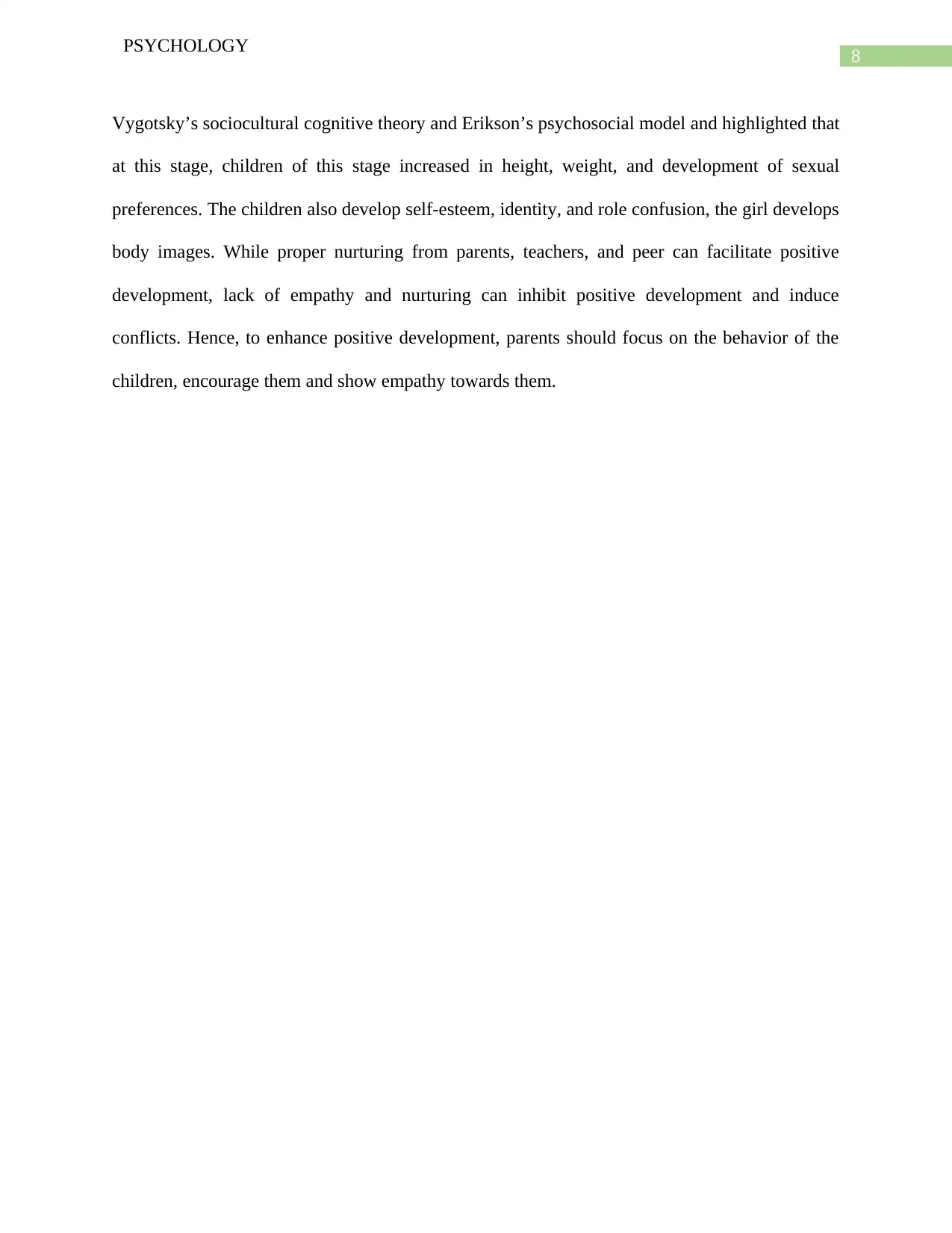
8
PSYCHOLOGY
Vygotsky’s sociocultural cognitive theory and Erikson’s psychosocial model and highlighted that
at this stage, children of this stage increased in height, weight, and development of sexual
preferences. The children also develop self-esteem, identity, and role confusion, the girl develops
body images. While proper nurturing from parents, teachers, and peer can facilitate positive
development, lack of empathy and nurturing can inhibit positive development and induce
conflicts. Hence, to enhance positive development, parents should focus on the behavior of the
children, encourage them and show empathy towards them.
PSYCHOLOGY
Vygotsky’s sociocultural cognitive theory and Erikson’s psychosocial model and highlighted that
at this stage, children of this stage increased in height, weight, and development of sexual
preferences. The children also develop self-esteem, identity, and role confusion, the girl develops
body images. While proper nurturing from parents, teachers, and peer can facilitate positive
development, lack of empathy and nurturing can inhibit positive development and induce
conflicts. Hence, to enhance positive development, parents should focus on the behavior of the
children, encourage them and show empathy towards them.
⊘ This is a preview!⊘
Do you want full access?
Subscribe today to unlock all pages.

Trusted by 1+ million students worldwide
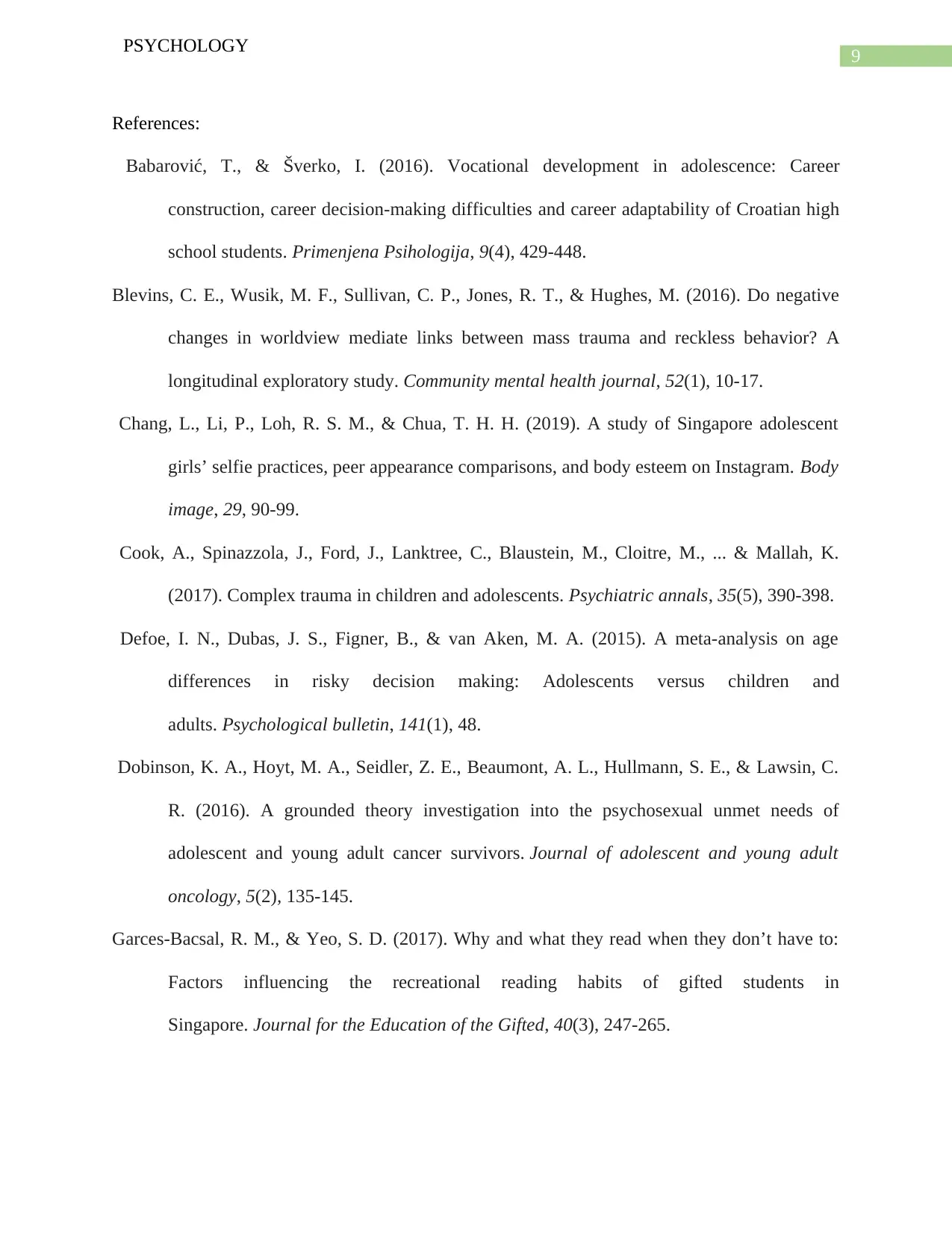
9
PSYCHOLOGY
References:
Babarović, T., & Šverko, I. (2016). Vocational development in adolescence: Career
construction, career decision-making difficulties and career adaptability of Croatian high
school students. Primenjena Psihologija, 9(4), 429-448.
Blevins, C. E., Wusik, M. F., Sullivan, C. P., Jones, R. T., & Hughes, M. (2016). Do negative
changes in worldview mediate links between mass trauma and reckless behavior? A
longitudinal exploratory study. Community mental health journal, 52(1), 10-17.
Chang, L., Li, P., Loh, R. S. M., & Chua, T. H. H. (2019). A study of Singapore adolescent
girls’ selfie practices, peer appearance comparisons, and body esteem on Instagram. Body
image, 29, 90-99.
Cook, A., Spinazzola, J., Ford, J., Lanktree, C., Blaustein, M., Cloitre, M., ... & Mallah, K.
(2017). Complex trauma in children and adolescents. Psychiatric annals, 35(5), 390-398.
Defoe, I. N., Dubas, J. S., Figner, B., & van Aken, M. A. (2015). A meta-analysis on age
differences in risky decision making: Adolescents versus children and
adults. Psychological bulletin, 141(1), 48.
Dobinson, K. A., Hoyt, M. A., Seidler, Z. E., Beaumont, A. L., Hullmann, S. E., & Lawsin, C.
R. (2016). A grounded theory investigation into the psychosexual unmet needs of
adolescent and young adult cancer survivors. Journal of adolescent and young adult
oncology, 5(2), 135-145.
Garces-Bacsal, R. M., & Yeo, S. D. (2017). Why and what they read when they don’t have to:
Factors influencing the recreational reading habits of gifted students in
Singapore. Journal for the Education of the Gifted, 40(3), 247-265.
PSYCHOLOGY
References:
Babarović, T., & Šverko, I. (2016). Vocational development in adolescence: Career
construction, career decision-making difficulties and career adaptability of Croatian high
school students. Primenjena Psihologija, 9(4), 429-448.
Blevins, C. E., Wusik, M. F., Sullivan, C. P., Jones, R. T., & Hughes, M. (2016). Do negative
changes in worldview mediate links between mass trauma and reckless behavior? A
longitudinal exploratory study. Community mental health journal, 52(1), 10-17.
Chang, L., Li, P., Loh, R. S. M., & Chua, T. H. H. (2019). A study of Singapore adolescent
girls’ selfie practices, peer appearance comparisons, and body esteem on Instagram. Body
image, 29, 90-99.
Cook, A., Spinazzola, J., Ford, J., Lanktree, C., Blaustein, M., Cloitre, M., ... & Mallah, K.
(2017). Complex trauma in children and adolescents. Psychiatric annals, 35(5), 390-398.
Defoe, I. N., Dubas, J. S., Figner, B., & van Aken, M. A. (2015). A meta-analysis on age
differences in risky decision making: Adolescents versus children and
adults. Psychological bulletin, 141(1), 48.
Dobinson, K. A., Hoyt, M. A., Seidler, Z. E., Beaumont, A. L., Hullmann, S. E., & Lawsin, C.
R. (2016). A grounded theory investigation into the psychosexual unmet needs of
adolescent and young adult cancer survivors. Journal of adolescent and young adult
oncology, 5(2), 135-145.
Garces-Bacsal, R. M., & Yeo, S. D. (2017). Why and what they read when they don’t have to:
Factors influencing the recreational reading habits of gifted students in
Singapore. Journal for the Education of the Gifted, 40(3), 247-265.
Paraphrase This Document
Need a fresh take? Get an instant paraphrase of this document with our AI Paraphraser
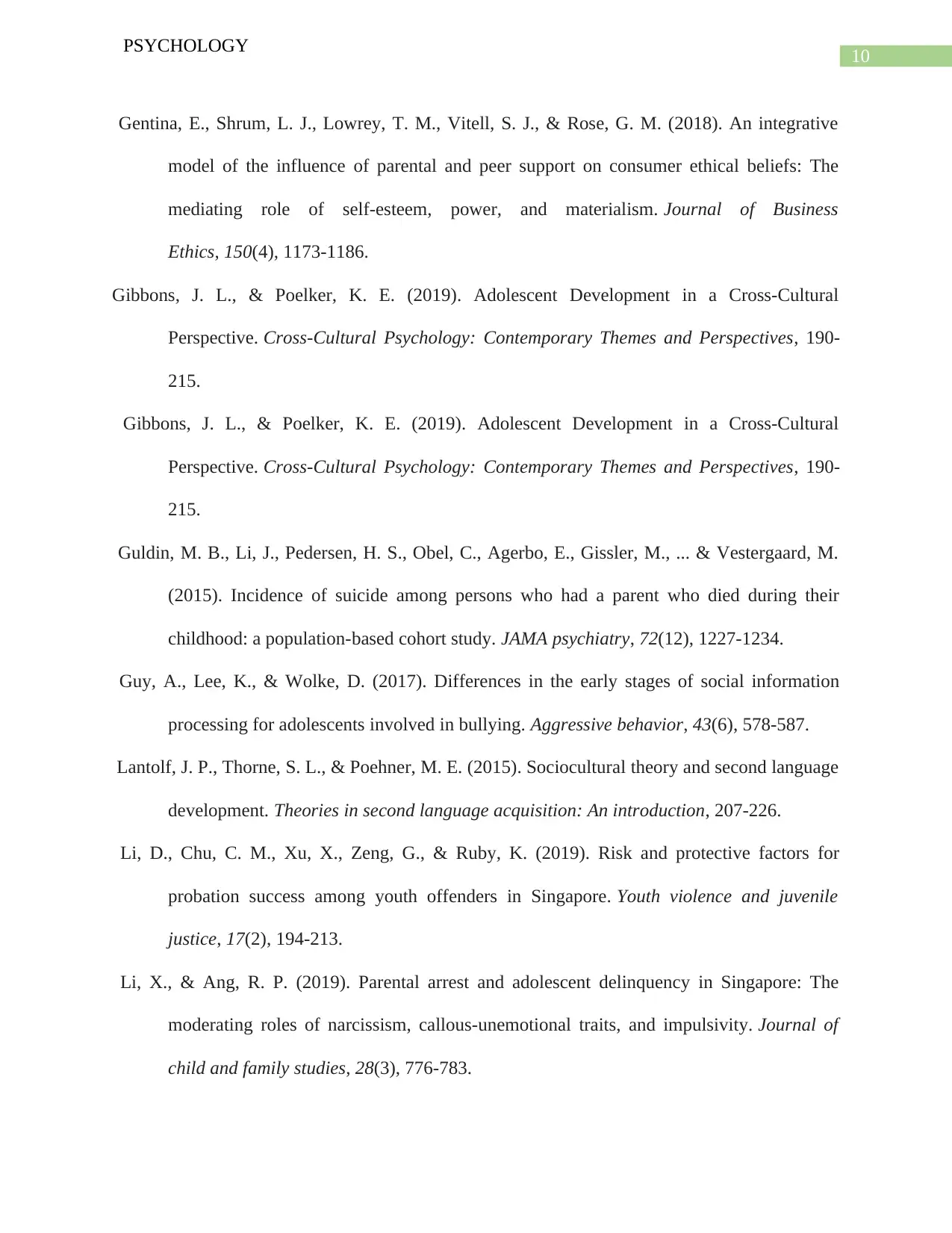
10
PSYCHOLOGY
Gentina, E., Shrum, L. J., Lowrey, T. M., Vitell, S. J., & Rose, G. M. (2018). An integrative
model of the influence of parental and peer support on consumer ethical beliefs: The
mediating role of self-esteem, power, and materialism. Journal of Business
Ethics, 150(4), 1173-1186.
Gibbons, J. L., & Poelker, K. E. (2019). Adolescent Development in a Cross‐Cultural
Perspective. Cross‐Cultural Psychology: Contemporary Themes and Perspectives, 190-
215.
Gibbons, J. L., & Poelker, K. E. (2019). Adolescent Development in a Cross‐Cultural
Perspective. Cross‐Cultural Psychology: Contemporary Themes and Perspectives, 190-
215.
Guldin, M. B., Li, J., Pedersen, H. S., Obel, C., Agerbo, E., Gissler, M., ... & Vestergaard, M.
(2015). Incidence of suicide among persons who had a parent who died during their
childhood: a population-based cohort study. JAMA psychiatry, 72(12), 1227-1234.
Guy, A., Lee, K., & Wolke, D. (2017). Differences in the early stages of social information
processing for adolescents involved in bullying. Aggressive behavior, 43(6), 578-587.
Lantolf, J. P., Thorne, S. L., & Poehner, M. E. (2015). Sociocultural theory and second language
development. Theories in second language acquisition: An introduction, 207-226.
Li, D., Chu, C. M., Xu, X., Zeng, G., & Ruby, K. (2019). Risk and protective factors for
probation success among youth offenders in Singapore. Youth violence and juvenile
justice, 17(2), 194-213.
Li, X., & Ang, R. P. (2019). Parental arrest and adolescent delinquency in Singapore: The
moderating roles of narcissism, callous-unemotional traits, and impulsivity. Journal of
child and family studies, 28(3), 776-783.
PSYCHOLOGY
Gentina, E., Shrum, L. J., Lowrey, T. M., Vitell, S. J., & Rose, G. M. (2018). An integrative
model of the influence of parental and peer support on consumer ethical beliefs: The
mediating role of self-esteem, power, and materialism. Journal of Business
Ethics, 150(4), 1173-1186.
Gibbons, J. L., & Poelker, K. E. (2019). Adolescent Development in a Cross‐Cultural
Perspective. Cross‐Cultural Psychology: Contemporary Themes and Perspectives, 190-
215.
Gibbons, J. L., & Poelker, K. E. (2019). Adolescent Development in a Cross‐Cultural
Perspective. Cross‐Cultural Psychology: Contemporary Themes and Perspectives, 190-
215.
Guldin, M. B., Li, J., Pedersen, H. S., Obel, C., Agerbo, E., Gissler, M., ... & Vestergaard, M.
(2015). Incidence of suicide among persons who had a parent who died during their
childhood: a population-based cohort study. JAMA psychiatry, 72(12), 1227-1234.
Guy, A., Lee, K., & Wolke, D. (2017). Differences in the early stages of social information
processing for adolescents involved in bullying. Aggressive behavior, 43(6), 578-587.
Lantolf, J. P., Thorne, S. L., & Poehner, M. E. (2015). Sociocultural theory and second language
development. Theories in second language acquisition: An introduction, 207-226.
Li, D., Chu, C. M., Xu, X., Zeng, G., & Ruby, K. (2019). Risk and protective factors for
probation success among youth offenders in Singapore. Youth violence and juvenile
justice, 17(2), 194-213.
Li, X., & Ang, R. P. (2019). Parental arrest and adolescent delinquency in Singapore: The
moderating roles of narcissism, callous-unemotional traits, and impulsivity. Journal of
child and family studies, 28(3), 776-783.
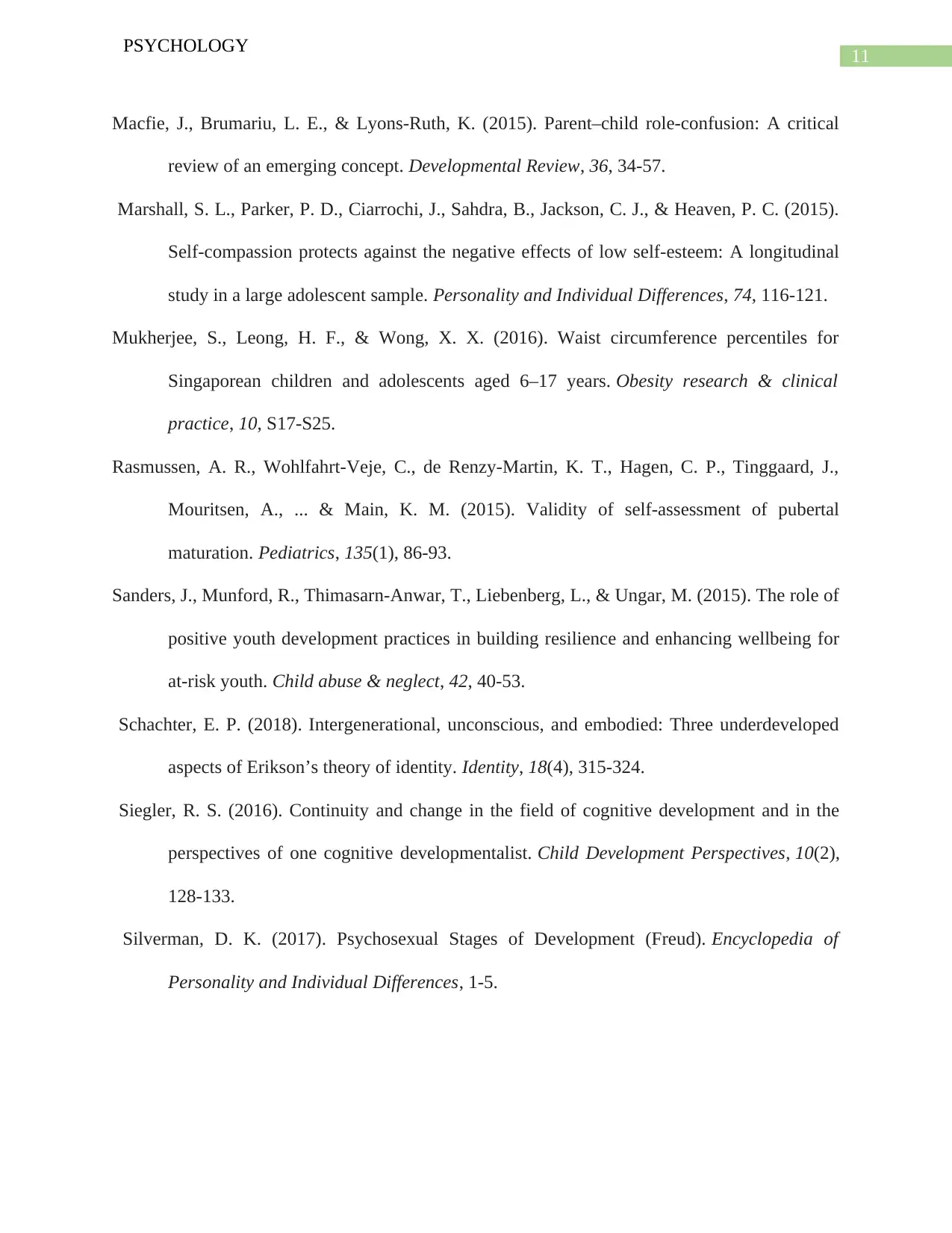
11
PSYCHOLOGY
Macfie, J., Brumariu, L. E., & Lyons-Ruth, K. (2015). Parent–child role-confusion: A critical
review of an emerging concept. Developmental Review, 36, 34-57.
Marshall, S. L., Parker, P. D., Ciarrochi, J., Sahdra, B., Jackson, C. J., & Heaven, P. C. (2015).
Self-compassion protects against the negative effects of low self-esteem: A longitudinal
study in a large adolescent sample. Personality and Individual Differences, 74, 116-121.
Mukherjee, S., Leong, H. F., & Wong, X. X. (2016). Waist circumference percentiles for
Singaporean children and adolescents aged 6–17 years. Obesity research & clinical
practice, 10, S17-S25.
Rasmussen, A. R., Wohlfahrt-Veje, C., de Renzy-Martin, K. T., Hagen, C. P., Tinggaard, J.,
Mouritsen, A., ... & Main, K. M. (2015). Validity of self-assessment of pubertal
maturation. Pediatrics, 135(1), 86-93.
Sanders, J., Munford, R., Thimasarn-Anwar, T., Liebenberg, L., & Ungar, M. (2015). The role of
positive youth development practices in building resilience and enhancing wellbeing for
at-risk youth. Child abuse & neglect, 42, 40-53.
Schachter, E. P. (2018). Intergenerational, unconscious, and embodied: Three underdeveloped
aspects of Erikson’s theory of identity. Identity, 18(4), 315-324.
Siegler, R. S. (2016). Continuity and change in the field of cognitive development and in the
perspectives of one cognitive developmentalist. Child Development Perspectives, 10(2),
128-133.
Silverman, D. K. (2017). Psychosexual Stages of Development (Freud). Encyclopedia of
Personality and Individual Differences, 1-5.
PSYCHOLOGY
Macfie, J., Brumariu, L. E., & Lyons-Ruth, K. (2015). Parent–child role-confusion: A critical
review of an emerging concept. Developmental Review, 36, 34-57.
Marshall, S. L., Parker, P. D., Ciarrochi, J., Sahdra, B., Jackson, C. J., & Heaven, P. C. (2015).
Self-compassion protects against the negative effects of low self-esteem: A longitudinal
study in a large adolescent sample. Personality and Individual Differences, 74, 116-121.
Mukherjee, S., Leong, H. F., & Wong, X. X. (2016). Waist circumference percentiles for
Singaporean children and adolescents aged 6–17 years. Obesity research & clinical
practice, 10, S17-S25.
Rasmussen, A. R., Wohlfahrt-Veje, C., de Renzy-Martin, K. T., Hagen, C. P., Tinggaard, J.,
Mouritsen, A., ... & Main, K. M. (2015). Validity of self-assessment of pubertal
maturation. Pediatrics, 135(1), 86-93.
Sanders, J., Munford, R., Thimasarn-Anwar, T., Liebenberg, L., & Ungar, M. (2015). The role of
positive youth development practices in building resilience and enhancing wellbeing for
at-risk youth. Child abuse & neglect, 42, 40-53.
Schachter, E. P. (2018). Intergenerational, unconscious, and embodied: Three underdeveloped
aspects of Erikson’s theory of identity. Identity, 18(4), 315-324.
Siegler, R. S. (2016). Continuity and change in the field of cognitive development and in the
perspectives of one cognitive developmentalist. Child Development Perspectives, 10(2),
128-133.
Silverman, D. K. (2017). Psychosexual Stages of Development (Freud). Encyclopedia of
Personality and Individual Differences, 1-5.
⊘ This is a preview!⊘
Do you want full access?
Subscribe today to unlock all pages.

Trusted by 1+ million students worldwide
1 out of 13
Related Documents
Your All-in-One AI-Powered Toolkit for Academic Success.
+13062052269
info@desklib.com
Available 24*7 on WhatsApp / Email
![[object Object]](/_next/static/media/star-bottom.7253800d.svg)
Unlock your academic potential
Copyright © 2020–2025 A2Z Services. All Rights Reserved. Developed and managed by ZUCOL.




